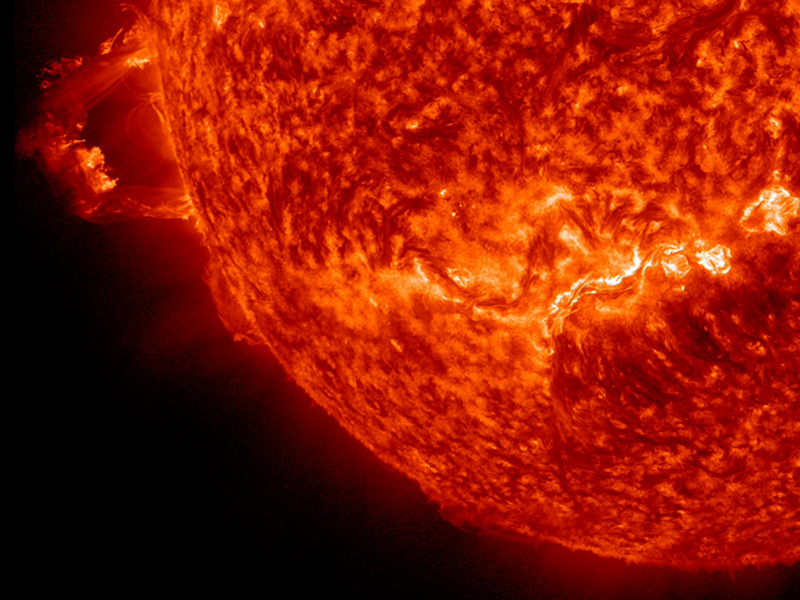
Moscow appears at the center of this nighttime image photographed by the Expedition 30 crew aboard the International Space Station, flying at an altitude of approximately 240 miles on March 28, 2012. A solar array panel for the space station is on the left side of the frame. The view is to the north-northwest from a nadir of approximately 49.4 degrees north latitude and 42.1 degrees east longitude, about 100 miles west-northwest of Volgograd. The Aurora Borealis, airglow and daybreak frame the horizon. Photo Credit: NASA
April 30, 2012 Vol. 5, Issue 4
The risks associated with space exploration are not purely technical.

Moscow appears at the center of this nighttime image photographed by the Expedition 30 crew aboard the International Space Station, flying at an altitude of approximately 240 miles on March 28, 2012. A solar array panel for the space station is on the left side of the frame. The view is to the north-northwest from a nadir of approximately 49.4 degrees north latitude and 42.1 degrees east longitude, about 100 miles west-northwest of Volgograd. The Aurora Borealis, airglow and daybreak frame the horizon.
Photo Credit: NASA
In the mid-1960s one of NASA’s visionary leaders, George Mueller, saw great promise and value for the nation in the Apollo Applications Program. Among other things, this program would ensure that all the hardware developed for Apollo would be put to use on missions following the lunar landing. Mueller’s plan called for both extended-duration manned missions as well as a wide array of space science missions.
Mueller’s proposal for the Apollo Applications Program did not survive contact with political reality. In 1966, with the Vietnam War demanding an increasing share of the federal budget, Congress significantly slashed the program’s budget for the coming year. By 1970 it was renamed the Skylab Program, much narrower in scope than the grand plans Mueller had envisioned five years earlier.
The Apollo Applications Program serves as a healthy reminder that even in NASA’s so-called “golden age,” the agency’s programs faced significant political risk. Over time the importance of the political dimension increased, as veterans of the transition from Apollo to Shuttle can attest. This was not unique to NASA. “Because the relationship between a project and its political environment are so important to project success, greater demands are placed on the skills of project managers,” wrote Edwin Merrow in a 1988 RAND study of megaprojects. These demands on project managers have only increased in the years since Merrows study.
I have written in the past about political and social risks.
Borrowing from a definition of political risk by analysts Ian Bremmer and Preston Keat, we can understand it as the probability that a political action will produce changes in program or project outcomes.* While the complexities of the budgeting process can make it hard to quantify the political risk to a specific program or project as a numeric probability, it is still valuable to consider the likelihood and consequences. We most often think about political risks in relation to funding decisions, and for good reason: budgets are a clear manifestation of political decision-making. But in an era where the vast majority of our projects include international partners, there can also be geopolitical risks related to events having nothing to do with space exploration.
Social risk in a project context is best thought of in terms of the likelihood that social effects can lead to a negative outcome for a program or project. This can manifest itself either through common biases such as anchoring (becoming overly attached to a first estimate as a point of reference), or through group dynamics such as groupthink or organizational silence. Social risk is even more difficult to quantify than political risk because it is deeply tied to an organization’s culture. It poses fewer problems in organizations that empower people to ask questions and challenge assumptions, but it is always present because we are all susceptible to biases in our own thinking. When our mishap and anomaly reports emphasize the crucial role of communications in avoiding the same mistakes in the future, they are talking about mitigating these social risks.
We have known about political and social risks for quite a while, but we have a long way to go in terms of systematically tracking and mitigating them. They require different training and tools than technical risks, but that does not mean they should be treated as secondary. Mission success depends on our ability to manage them.
* See Ian Bremmer and Preston Keat, The Fat Tail: The Power of Political Knowledge for Strategic Investing, Oxford University Press, 2009.









